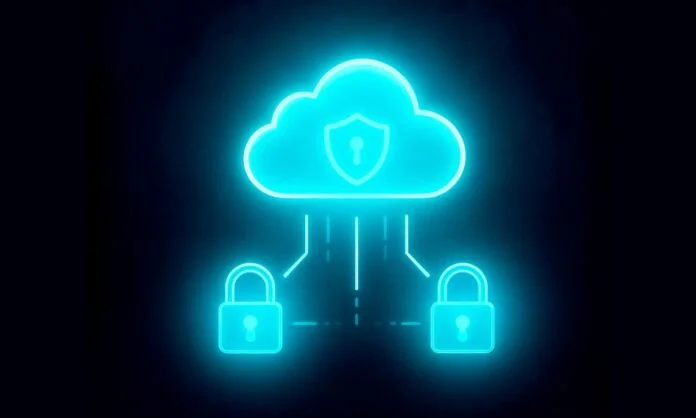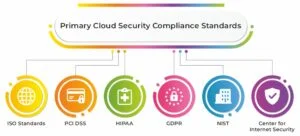It has now become extremely important to maintain strong levels of cloud security due to the rapid shift of organizations moving their work to the cloud. With the growing number of cyber-attacks on organizations, increased regulatory requirements regarding data privacy, and emerging privacy and data protection issues, organizations are incorporating implementations of compliance processes to protect sensitive data.
Alongside, they must comply with data security requirements, including protecting sensitive data from potential threats that may hinder attract growth. According to reports, 54% of data stored in cloud is sensitive, which has increased from 47% as compared to the past year.
In this blog, we will provide an overview of cloud security compliance, including key legislative frameworks, common organizational challenges, and recommendations for protecting sensitive data in the cloud.
Let’s get started!
What’s Cloud Security Compliance?
Cloud security compliance is the process of ensuring that cloud-based systems, applications, and data stores meet industry standards, regulations, legal requirements, or security standards. Regulatory agencies establish standards to protect the data of businesses and customers from data breaches, leaks, or misuse by employees of companies.
Cloud environments often involve shared responsibility models between cloud service providers (CSPs) and customers’ IT teams. While on-premises systems allow IT teams to have complete control over a physical infrastructure, cloud environments often utilize complex shared systems. Compliance is both complex and necessary.
Some compliance regulations are specific to a particular industry (e.g., HIPAA for healthcare, PCI DSS for financial services), while others are general-purpose regulations that apply to multiple industries. (e.g., GDPR, ISO).
Why Cloud Security Compliance Matters?
- Stoves are off unauthorized access, leaks, and breaches of sensitive data.
- Complies with legal obligations: Is immune from fines and penalties for non-compliance.
- Enhances brand awareness among customers by implementing measures to protect personal information.
- Benefits business: Enables organizations to operate in global markets with diverse compliance standards.
What are the Primary Cloud Security Compliance Standards?
Several compliance frameworks are utilized to guide organizations in safeguarding their cloud workloads. Listed below are the most notable ones:
1. ISO Standards
Information Security Management Systems (ISMS) can be certified globally through the use of ISO 27001. A structure is established to ensure the systematic protection of data while continuously enhancing security measures.
Both customers and cloud providers were guided by ISO 27017, an extension that focused on security controls specific to the cloud.
Public clouds are protected by the personal identifiable information (PII) under ISO 27018.
Industry-specific compatibility is a key feature of these standards, which are not dependent on technology.
2. PCI DSS
Applies to companies that process credit card payments in the EU.
Secures payment data through the processing, transmission, and storage in the cloud.
Involves requirements such as:
- Secure networks
- Strong access control measures
- Continuous monitoring and testing
- Encrypted data transmission
3. HIPAA
Consists of hospitals, insurers, and their suppliers.
Secures cloud-based health information (PHI).
Requires:
- Encryption of PHI
- Access restrictions
- Regular risk assessments
- Data backup and recovery processes
4. GDPR (General Data Protection Regulation)
Regulations are implemented throughout the European Union (EU), but they apply to any organization that manages the data of EU citizens.
Must handle personal data in a legal, secure, and transparent manner.’
Key requirements:
- Explicit consent from users
- Right to inspect, amend, or eliminate information
- Data minimization and pseudonymization
- Breach notification obligations
5. NIST
NIST is the acronym for the National Institute of Standards and Technology. It include US-based guidelines with global adoption.
Provides frameworks like:
- NIST SP 800-210 provides guidance on cloud access control.
- Notably known for its extensive risk assessment capabilities.
6. Center for Internet Security
The Center for Internet Security oversees the internet security system. It presents 20 specific security controls for the protection of cloud-based systems.
- Separated into fundamental, underlying, and organizational controls.
- Targeted at various regulatory agencies and organizations.
Sharing the Cloud Security Compliance Best Practices-
The following are recommended approaches for organizations to enhance compliance and mitigate risk.
1. Data Encryption Everywhere.
Safeguard confidential data throughout the duration, from entry to departure, and during usage. Integration with cloud-native encryption services from AWS, Azure, and GCP is also possible.
2. Principle of Least Privilege (PoLP)
Ensure that users are granted only the permissions required for their roles. Use RBAC to automate access controls.
3. Zero Trust Security Model.
It is essential to verify and never trust. Every access request must be authenticated and authorized.
4. Well-Architected Frameworks.
To ensure compliance and security, utilize frameworks such as the AWS Well-Architected Framework to map your cloud infrastructure.
5. Continuous Monitoring & Auditing.
Use tools for real-time monitoring, threat detection, and compliance reporting. This keeps up with the standards.’
6. Employee Awareness & Training.
Inform employees about compliance obligations and safe cloud practices to minimize risks.
What’s New in Cloud Security Compliance?
With the advent of new technologies and increasing threats, cloud security compliance will continue to evolve:
- Automation and AI will improve the reporting of compliance.
- Privacy-enhancing technologies (PETs), including homomorphic encryption, are expected to gain traction.
Wrapping it Up!
Hope the above blog has helped you understand cloud security compliance. It is essential to adhere to cloud security compliance standards and practices to stay vigilant and ahead in cyberspace.
Visit our site to stay informed about all the blogs around the tech landscape.
FAQs:
1. What are the 4 Cs of cloud security?
Answer: The 4 Cs of cloud security are: Cloud, cluster, code, and container. Organizations can apply these to secure their sensitive data.
2. What is the ISO standard for cloud security?
Answer: The leading ISO standard for cloud security is ISO/IEC 27017.
Recommended For You:
What is the purpose of cloud rapid elasticity in Cloud Computing?


